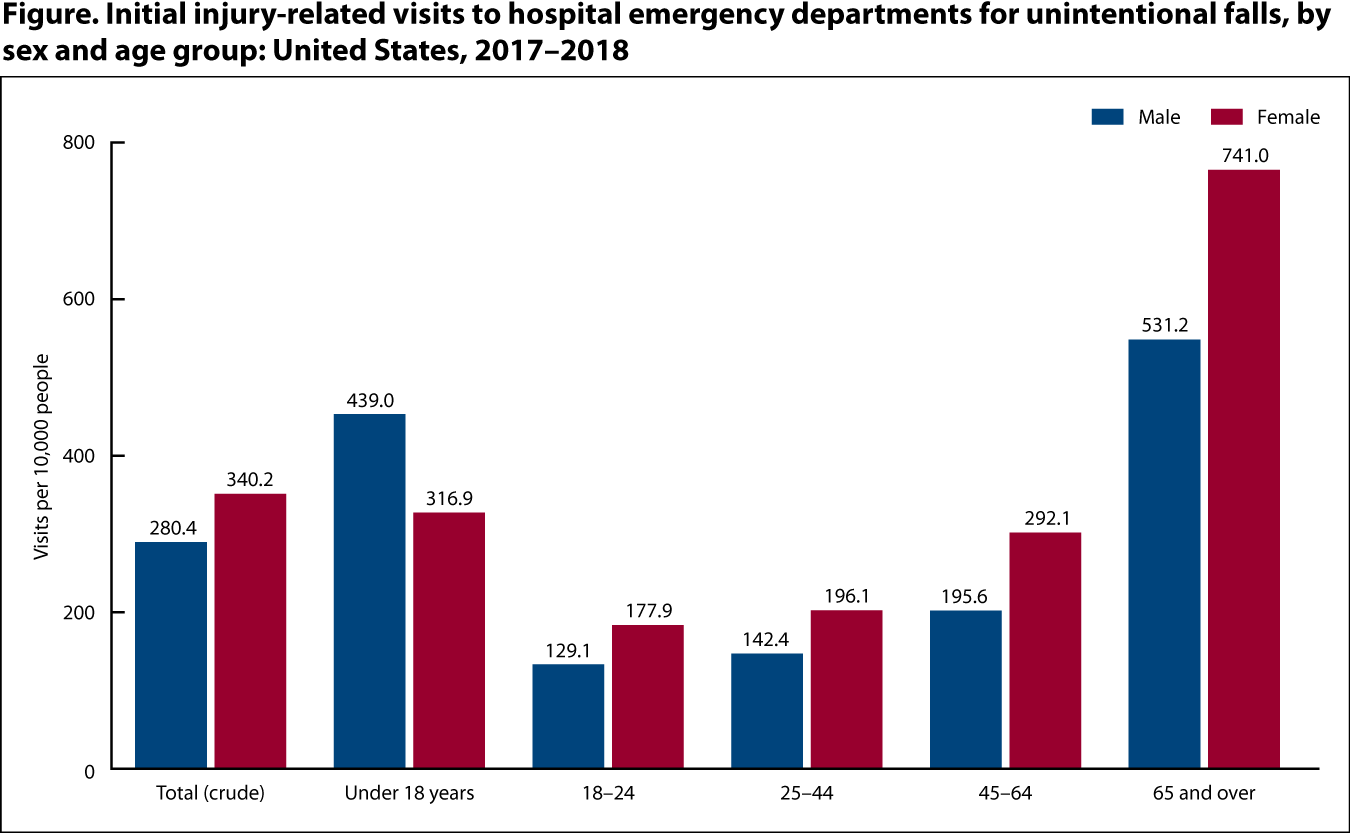Injury Visits
The content on this page was last updated in June 2023. More recent estimates and visualizations may be available from the NCHS Data Query System.
In direct medical costs and lost productivity, the cost of injuries is substantial to both individuals and society (1–3). In 2019, unintentional poisoning (including unintentional drug overdose) was the leading cause of injury deaths for people of all ages, while unintentional falls were the leading cause of nonfatal injuries (4,5).
Key Findings

In 2007–2008, the age-adjusted rate of initial injury-related visits to hospital emergency departments was 960.9 per 10,000 people. The age-adjusted rate of initial injury-related visits to hospital emergency departments was stable from 2007–2008 to 2013–2014 (1,047.8 in 2013–2014). In 2017–2018, the rate of injury visits was 1,035.6. See Featured Charts for additional analyses.
SOURCE: National Center for Health Statistics, National Hospital Ambulatory Medical Care Survey. See Sources and Definitions, National Hospital Ambulatory Medical Care Survey (NHAMCS) and Health, United States 2020–2021 Table InjEDVis.
In 2017–2018, initial injury-related emergency department visit rates for unintentional falls were higher for females than for males, though differences varied by age group.

SOURCE: National Center for Health Statistics, National Hospital Ambulatory Medical Care Survey. See Sources and Definitions, National Hospital Ambulatory Medical Care Survey (NHAMCS) and Health, United States, 2020–2021 Table InjEDVis.
- Among people of all ages in 2017–2018, the initial injury-related emergency department visit rate for unintentional falls was higher for females (340.2 per 10,000 people) than for males (280.4).
- The initial injury-related emergency department visit rate for unintentional fall-related injuries was higher among women than among men for adults aged 25–44 (142.4 for men and 196.1 for women), 45–64 (195.6 for men and 292.1 for women), and 65 and over (531.2 for men and 741.0 for women). No significant difference was observed between men and women aged 18–24.
- Among children under age 18 years, the rate of initial injury-related emergency department visits for unintentional falls was higher for boys (439.0) than for girls (316.9).
- Among males, the rate of initial injury-related emergency department visits for unintentional falls was highest for boys under age 18 years and men aged 65 and over compared with other age groups.
- Among females, the rate of initial injury-related emergency department visits for unintentional falls was highest for women aged 65 and over compared with younger age groups.
Download the data
Initial injury-related visits to hospital emergency departments, by sex, age, and intent and mechanism of injury: United States, average annual, selected years 2005–2006 through 2017–2018
SOURCE: National Center for Health Statistics, National Hospital Ambulatory Medical Care Survey.
- Initial injury-related emergency department visit: Based on the diagnosis code and other factors collected on the National Hospital Ambulatory Medical Care Survey questionnaire. Starting with 2016 data, visits are classified according to the International Classification of Diseases, 10th Revision, Clinical Modification (ICD–10–CM). Therefore, the classification of injury-related visits for 2017–2018 is not strictly comparable with data for earlier years, which used the International Classification of Diseases, Ninth Revision, Clinical Modification. See Sources and Definitions, Emergency department; Emergency department or emergency room visit; Injury-related visit; International Classification of Diseases, Clinical Modification (ICD–CM); National Hospital Ambulatory Medical Care Survey (NHAMCS).
- Haegerich TM, Dahlberg LL, Simon TR, Baldwin GT, Sleet DA, Greenspan AI, Degutis LC. Prevention of injury and violence in the USA. Lancet 384(9937):64–74. 2014.
- Peterson C, Xu L, Barnett SBL. Average lost work productivity due to non-fatal injuries by type in the USA. Inj Prev 27(2):111–17. 2021.
- Peterson C, Xu L, Florence C. Average medical cost of fatal and non-fatal injuries by type in the USA. Inj Prev 27(1):24–33. 2021.
- Centers for Disease Control and Prevention. WISQARS: Leading causes of death reports, 1981–2019.
- Centers for Disease Control and Prevention. WISQARS: Leading causes of nonfatal injury reports, 2000–2019.


